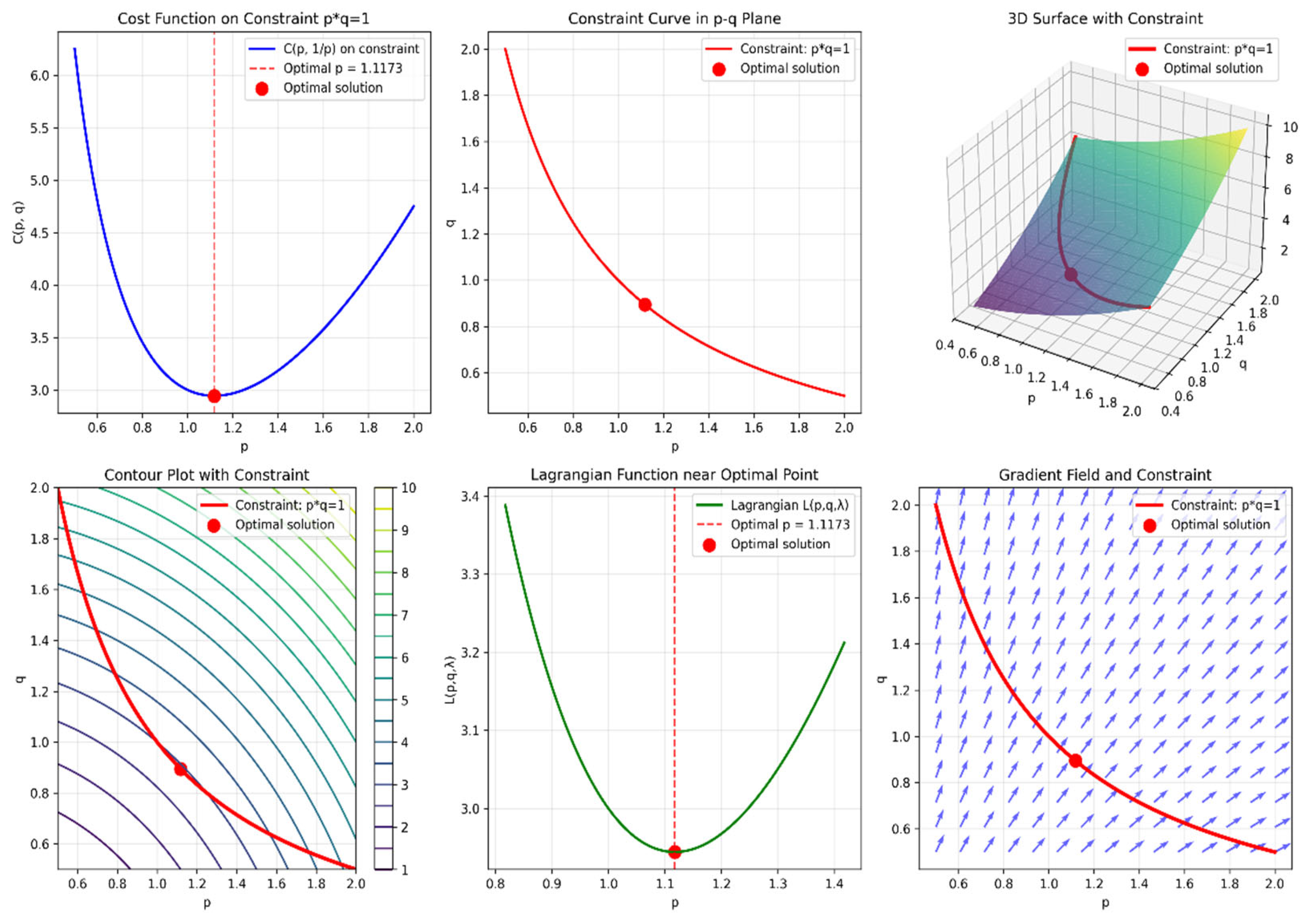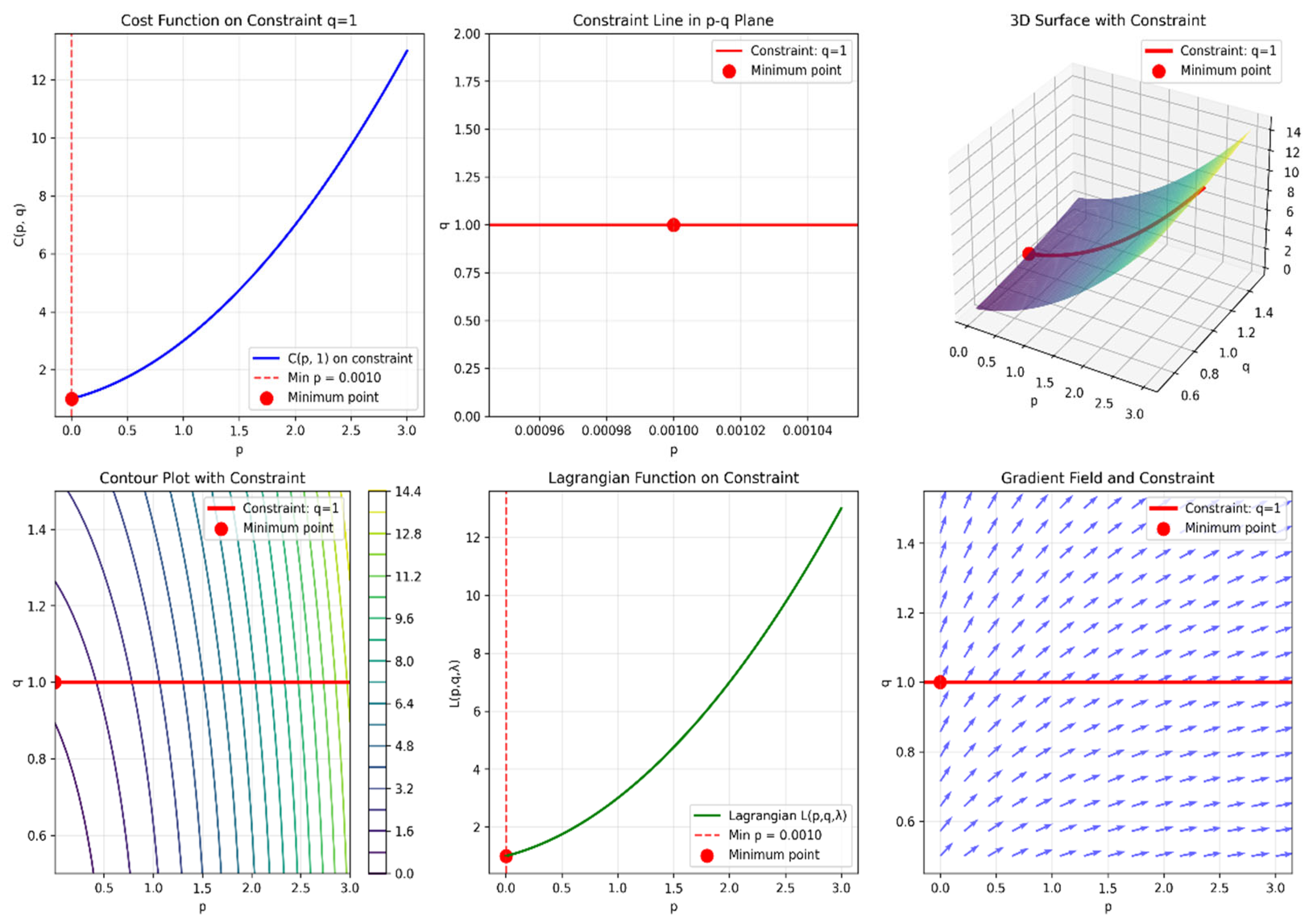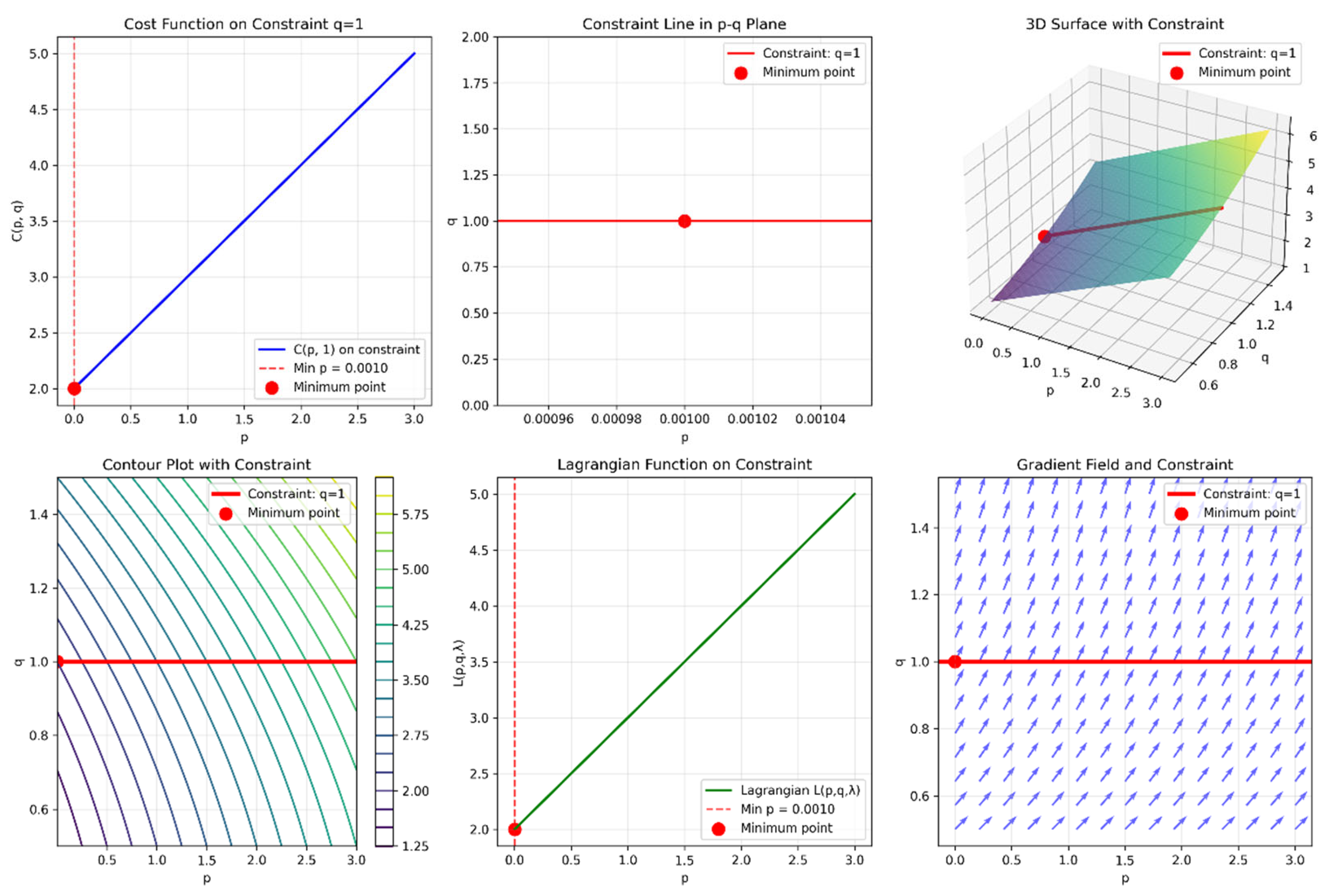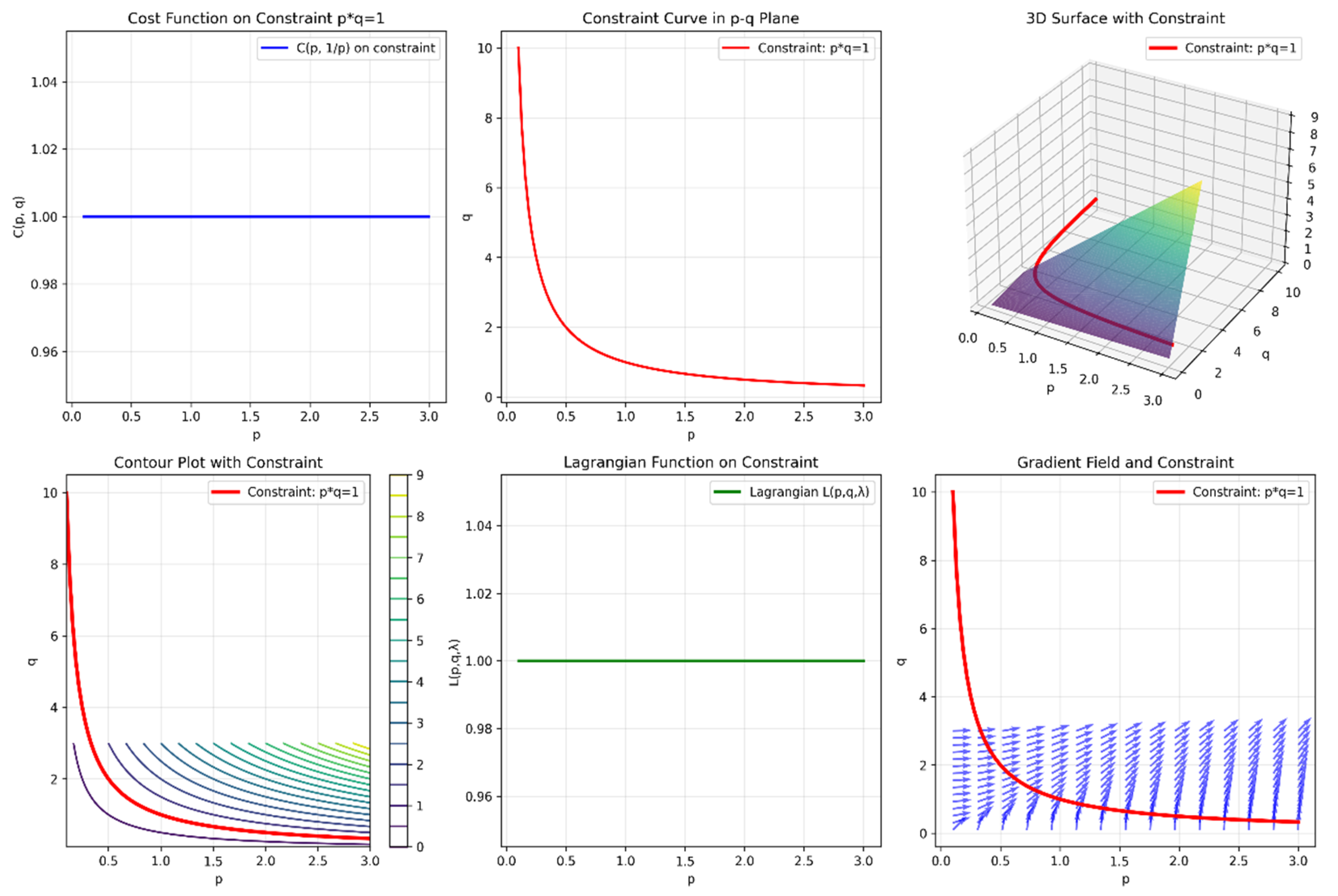Research on a Class of Optimization Problems of Higher Education Cost with Cobb–Douglas Constraint Condition
Abstract
1. Introduction
2. Model Analysis
- (i)
- If H is positive definite and , then the problem has a unique solution.
- (ii)
- If H is positive semidefinite and , then the problem may have multiple solutions.
3. Numerical Simulation
4. Discussion
- (1)
- Qualitative division of costs through the input–output theory. When measuring from the scale of input and output of Chinese universities, universities in mainland China can roughly be divided into three input–output combinations: ‘low input–high output,’ ‘high input–low output,’ and ‘low input–low output.’ The concepts of ‘high’ and ‘low’ are only rough comparative classifications, and it can be seen from the regression results in the existing literature that the relationship between the levels of input–output combinations and the efficiency of the input–output is not very clear. In other words, universities that invest heavily in educational resources and incur high corresponding costs do not necessarily achieve output that meets expectations. In the past, schools that were judged to have high educational quality based on absolute input and output, as well as some traditional prestigious universities, often performed unsatisfactorily in terms of education input–output efficiency. At the same time, there are cases where institutions achieved higher-than-expected output with relatively low resource input, because the cost of running the school was minimized (resource allocation is optimized). This leads us to think that, in order to accurately assess the actual operational cost of a university, the government should pay attention to examining the efficiency of the educational input and output, rather than simply evaluating based on absolute amounts.
- (2)
- The existing statistical analysis data supports the two basic results of this paper. According to the results of the existing research [23], among the 51 universities directly under the Ministry of Education in China, 62.75% have high education input–output efficiency, 13.73% have relatively high education input–output efficiency and 23.52% have basically no efficiency in their education input–output. These analytical data indicate that more than half of the universities in mainland China have a relatively reasonable allocation of educational resources, but there are still a small number of universities with problems of excessively high costs. This paper has provided corresponding improvement methods for reference. The problem of excessively high costs in some universities mainly manifests as a redundant investment, most of which is concentrated in financial and human resources, especially financial investment, which is often made without regard to cost. Under the wave of expanding enrollment in major universities, some universities blindly pursue quantity, building large-scale high-ranking faculty teams, resulting in high costs and greatly wasting valuable educational resources. In some cases, even with high costs, universities still produce unsatisfactory educational outcomes, which is truly regrettable.
- (3)
- Universities should establish a complete evaluation index system for educational input–output efficiency. The shortcomings of the existing evaluation system are obvious to all. Optimizing the evaluation system can help identify various problems in the allocation and use of educational resources. At the same time, scientific and comprehensive evaluation methods should be used to study the education cost and input–output efficiency of universities. Interdisciplinary innovation should be sought in the selection of methods, with the goal of fundamentally solving problems.
- (4)
- At present, there is a common problem in the Chinese mainland’s colleges and universities: that the input of educational resources is redundant. Taking the construction of the teaching staff in the investment of educational resources as an example, the teaching staff is an important foundation for the development of education. However, in recent years, the blind expansion of education investment has brought huge “costs of tinkering” and waste, resulting in a surge in education costs [20]. In addition, it also occurs in terms of financial investment, where the budget for financial investment is not scientific enough and financial waste occurs repeatedly. These practical problems pose challenges for innovative research methods and specific practices in the future.
5. Conclusions
Author Contributions
Funding
Data Availability Statement
Conflicts of Interest
References
- Price, J.A. How cost framing affects college applications: Evidence from a targeted information intervention. Econ. Educ. Rev. 2025, 107, 102677. [Google Scholar] [CrossRef]
- Gajderowicz, T.; Wincenciak, L.; Grotkowska, G. How much does a higher education in economics cost? DCE evaluation of the individual (dis)utility of studying. Int. Rev. Econ. Educ. 2024, 47, 100294. [Google Scholar] [CrossRef]
- Chao, L. Research on full cost accounting in Sino-foreign cooperative education institutions in universities: A Case study of T university. Money China 2023, 34, 84–86. [Google Scholar]
- Schouten, J.; Saavedra-Nieves, A.; Fiestras-Janeiro, M.G. Sequencing situations and games with non-linear cost functions under optimal order consistency. Eur. J. Oper. Res. 2021, 294, 734–745. [Google Scholar] [CrossRef]
- Gomez, M.A.; Michiels, W.; Mondié, S. Design of delay-based output-feedback controllers optimizing a quadratic cost function via the delay Lyapunov matrix. Automatica 2019, 107, 146–153. [Google Scholar] [CrossRef]
- Rebello, G.; Gondhalekar, R.; Dassau, E.; Doyle, F.J., III. Mixed Linear-quadratic cost function design for MPC of an artificial pancreas—improved treatment & safety for a broad range of meal sizes. IFAC-PapersOnLine 2017, 50, 7724–7730. [Google Scholar]
- Hongyi, T. Research on compliance governance of affiliated transaction in private universities. Heilongjiang High. Educ. Res. 2023, 41, 39–43. [Google Scholar]
- Guiyan, C.; Mingda, L.; Shuang, H.; Zhanli, M.; Jingchao, C. Research on the financial accounting reporting system of Sino-foreign cooperative education in universities from the perspective of Full-cost accounting: A case study of M university. Stud. Financ. Account. Educ. 2022, 33, 54–62. [Google Scholar]
- Oskarsson, B. Total cost analysis in purchasing education: A two-step open-ended teaching case approach. J. Purch. Supply Manag. 2025, 31, 100971. [Google Scholar] [CrossRef]
- Glass, J.C.; McKillop, D.G.; Hyndman, N.S. Efficiency in the provision of university teaching and research: An empirical analysis of UK universities. J. Appl. Econom. 1995, 10, 61–72. [Google Scholar] [CrossRef]
- Kim, J.; Nakano, S.; Nishimura, K. Multifactor CES general equilibrium: Models and applications. Econ. Model. 2017, 63, 115–127. [Google Scholar] [CrossRef]
- Baumol, W.J.; Panzar, J.C.; Willig, R.D. Contestable Markets and the Theory of Industry Structure; Harcourt Brace Jovanovich: San Diego, CA, USA, 1982. [Google Scholar]
- Zhang, X.; Sun, D.; Jiang, W. Dynamics of ahet erogeneous quantumcournot duopoly with adjusting players and quadratic costs. Quantum Inf. Process. 2020, 19, 403. [Google Scholar] [CrossRef]
- Feiyu, Z.; Huisheng, Z.; Jian, W. A widely linear noise-constrained adaptive filtering algorithm with a non-quadratic cost function. Digit. Signal Process. 2025, 165, 105333. [Google Scholar] [CrossRef]
- Azioune, M.; Abdelouahab, M.S. Controlling chaos and mixed mode oscillations in a Bertrand duopoly game with homogeneous expectations and quadratic cost functions. Math. Comput. Simul. 2025, 233, 553–566. [Google Scholar] [CrossRef]
- Yong, D.; Hanlei, W.; Wei, R. Distributed continuous-time time-varying optimization for networked Lagrangian systems with quadratic cost functions. Automatica 2025, 171, 111882. [Google Scholar] [CrossRef]
- Johnes, G. Multiproduct cost functions and the funding of tuition in UK universities. Appl. Econ. Lett. 1996, 3, 557–561. [Google Scholar] [CrossRef]
- Mian, A.; Ensinas, A.V.; Marechal, F. Multi-objective optimization of SNG production from microalgae through hydrothermal gasification. Comput. Chem. Eng. 2015, 76, 170–183. [Google Scholar] [CrossRef]
- Yu, B.Z.; Lu, M.X. Analysis for a Sort of Higher Education Cost from the View at Constrain of Cobb-Douglas function. In Proceedings of the ICBDIE, Beijing, China, 8–10 April 2022. [Google Scholar]
- Wang, L. Empirical Estimate of Education Cost Function for University and Its Application. Master’s Thesis, Suzhou University, Suzhou, China, 2009. [Google Scholar]
- Boyd, S.P.; Vandenberghe, L. Convex Optimization; Cambridge University Press: Cambridge, UK, 2004. [Google Scholar]
- Horn, R.A.; Johnson, C.R. Matrix Analysis; Cambridge University Press: Cambridge, UK, 2012. [Google Scholar]
- Jin, L. A Study on the Measurement of Input-Output Efficiency of Higher Education in China Based on Comprehensive Evaluation Method. Master’s Thesis, Jinan University, Guangzhou, China, 2019. [Google Scholar] [CrossRef]






| Symbol | Parameter Definition |
|---|---|
| the amount of total cost change that is caused by the price of the kth product of the input product increasing by one unit. | |
| the amount of total cost change that was caused by the price of the ith product of the output product increasing by one unit. | |
| the price relationship coefficient between product k and product l of input products. | |
| the price relationship coefficient between product k and product l of output products. | |
| the price relationship coefficient between input product k and input product i. | |
| the sum of financial support that universities can provide for all input and output production and external resources of universities. | |
| the amount of the kth input product. | |
| the amount of the ith output product. |
Disclaimer/Publisher’s Note: The statements, opinions and data contained in all publications are solely those of the individual author(s) and contributor(s) and not of MDPI and/or the editor(s). MDPI and/or the editor(s) disclaim responsibility for any injury to people or property resulting from any ideas, methods, instructions or products referred to in the content. |
© 2025 by the authors. Licensee MDPI, Basel, Switzerland. This article is an open access article distributed under the terms and conditions of the Creative Commons Attribution (CC BY) license (https://creativecommons.org/licenses/by/4.0/).
Share and Cite
Lv, M.; Ji, P.; Ying, Y. Research on a Class of Optimization Problems of Higher Education Cost with Cobb–Douglas Constraint Condition. Symmetry 2025, 17, 2035. https://doi.org/10.3390/sym17122035
Lv M, Ji P, Ying Y. Research on a Class of Optimization Problems of Higher Education Cost with Cobb–Douglas Constraint Condition. Symmetry. 2025; 17(12):2035. https://doi.org/10.3390/sym17122035
Chicago/Turabian StyleLv, Mingxia, Ping Ji, and Yirong Ying. 2025. "Research on a Class of Optimization Problems of Higher Education Cost with Cobb–Douglas Constraint Condition" Symmetry 17, no. 12: 2035. https://doi.org/10.3390/sym17122035
APA StyleLv, M., Ji, P., & Ying, Y. (2025). Research on a Class of Optimization Problems of Higher Education Cost with Cobb–Douglas Constraint Condition. Symmetry, 17(12), 2035. https://doi.org/10.3390/sym17122035







